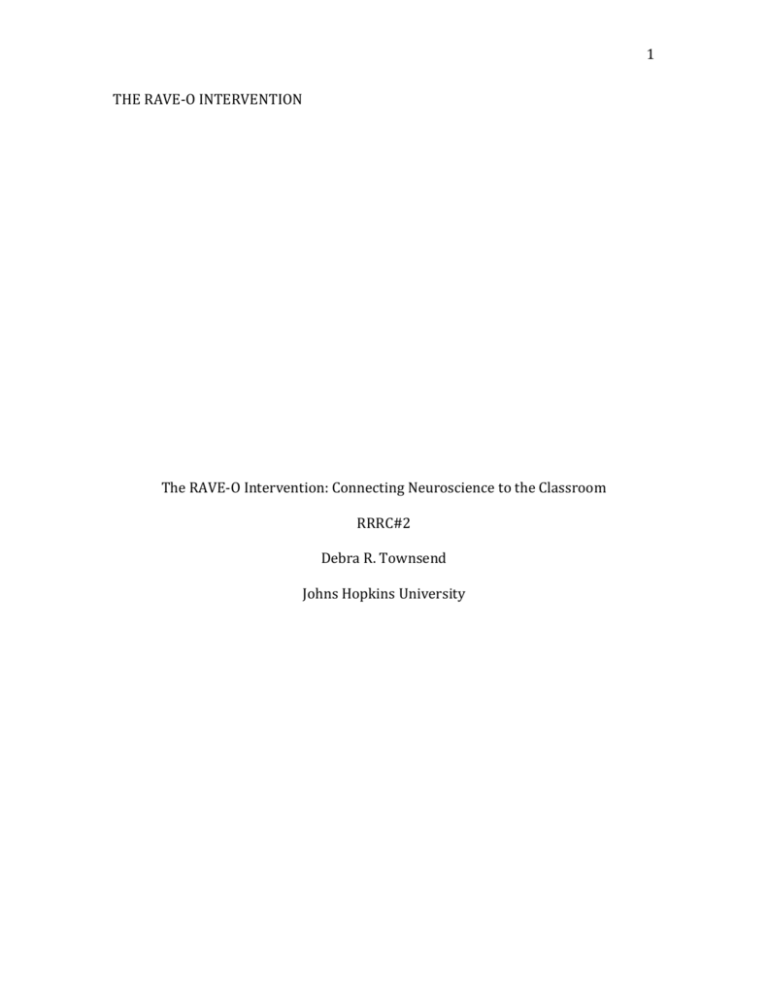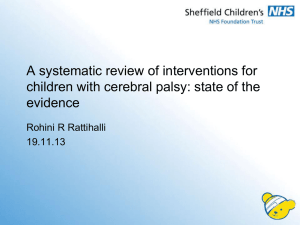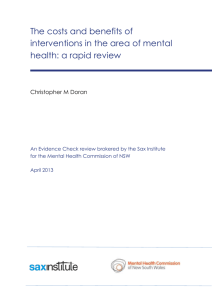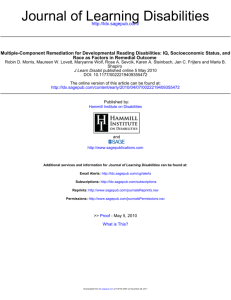The RAVE-O Intervention: Connecting Neuroscience to the Classroom
advertisement

1 THE RAVE-O INTERVENTION The RAVE-O Intervention: Connecting Neuroscience to the Classroom RRRC#2 Debra R. Townsend Johns Hopkins University 2 THE RAVE-O INTERVENTION In more recent years, interdisciplinary research has begun to make its way into many fields of study. This is also true of investigations into the underlying reasons why children may struggle with reading. In a recent article Wolf et al. (2009) discuss how insights from the fields of linguistics, cognitive neuroscience and education can shed light, not simply on the process of reading, but how reading interventions may be more effective when implementing a multicomponential model versus a unidimensional one. The authors of this case study explore the efficacy of using the RAVE-O (Retrieval, Automaticity, Vocabulary, Engagement with Language and Orthography) model and clearly demonstrate that students outperform controls on all levels measured regardless of socioeconomic status, IQ or ethnicity when compared to phonological based controls. Dyslexia, described more as an “untalent” by Denckla (Liam, 1999, 52), is a disability that interferes with the way the brain processes different speech sounds and how words are structured. Traditionally interventions have relied on a unidimensional view targeting phonological awareness. The author states that Denckla, Wolf and colleagues noticed a connection between rapid naming, used in RAN (Rapid Automatized Naming) and RAS (Rapid Alternating Stimulus), has a “predictive capacity” (p. 85) for reading readiness. She and others felt that naming speed and phoneme awareness are two different, but related sources of reading breakdown in early readers. This led them to the hypothesis that dyslexia is not simply a failure to decode the words, but involves an additional neural process or 3 circuit separate from phonology. The author reports that later neurological studies confirmed this theory. The designers of the RAVE-O intervention employed this insight and designed a multicomponential treatment using core words that shared phonemes designed sequenced orthographic patterns and employed rich, semantic structure and meaning. They incorporated elements of phonology, orthography, morphology, syntax and semantic knowledge into the intervention. The purpose of this study was to determine if this multicomponential, multilayered model would outperform the traditional phonics-based intervention. The authors designed a five-year randomized-control case study with 279 impaired readers in second and third grade. The participants received seventy hours of treatment and a battery of follow-up assessments. The RAVE-O model was compared to two groups using the PHAST model, also a multidimensional-style intervention, two control groups using traditional phonics interventions with study skills, and two classroom controls. Although the initial study did not examine a large group of participants, less than three hundred, its integrity is exemplary. I thought it was particularly valid in that the authors used two multicomponential models, RAVE-O and PHAST. The control groups were also varied increasing the reliability of the results. When the data was analyzed the authors found the efficacy of both multidimensional groups including the RAVE-O group and the PHAST model. These two approaches significantly “outperformed” both the phonics-based interventions as well as the classroom controls. They reported the RAVE-O group demonstrated 4 significant differences in “decoding, word reading, connecting text reading, and comprehension” (p. 90). In addition, significant differences were reported in vocabulary, comprehension, word-attack, word-identification and fluency when compared to the controls. They found comparable results between the RAVE-O and PHAST groups in decoding and word recognition. The authors were so successful with this intervention that they have begun to implement it in other school-based programs, summer school sessions and afterschool programs. In addition they are planning a series of interventions in a wider range of populations including children with “comorbid reading and socialemotional challenges” (p. 90). One of the most significant findings of this study is its success with children of varying IQ’s, socio-economic and ethnic backgrounds. These populations have traditionally struggled with reading; if an intervention can move these children past the stumbling blocks which have traditionally inhibited their reading success, the educational field should make every attempt to implement these interventions into their reading intervention programs. One of the aspects of this intervention, which I found particularly intriguing, is the possibility of integrating the big ideas into other subject matter. As an art educator, I bring a language-rich environment into my classroom. I use a broad vocabulary of art, science, math and social studies terms in my discussions as well as displays. It would be quite easy to bring core words into my classroom and lessons, if I knew what they were. As it is, I make every attempt to bring concepts and terms from the classroom curriculum into my lessons and language whenever possible. I could easily become a “language partner” using core words, demonstrating 5 phonological principles and morphology. I could also build on syntactic as well as semantic knowledge throughout my curriculum. One of the strategies I use to teach children to draw realistically is to create drawing sheets to refer to as they create their artistic products. I could envision “imagistic” sheets that parallel the core words they are learning in their interventions and build an even greater understanding of the semantic knowledge of those words. List of References Barzillai, M., Gottwald, S., Lovett, M., Miller, L., Morris, L., Norton, E., … Wolf, M. (2009). The RAVE-O intervention: Connecting neuroscience to the classroom. Mind, Brain, and Education, 3, 2, 84-93. Lium, A. (1999). What reading shows about the brain. Johns Hopkins Magazine, September 1999, 52-56.








